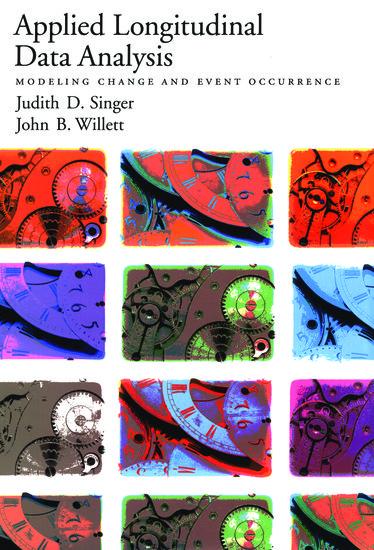
Zustellung: Mo, 04.08. - Fr, 08.08.
Versand in 3 Wochen
VersandkostenfreiBestellen & in Filiale abholen:
The investigation of change has fascinated empirical researchers for generations, and to do it well, they must have longitudinal data. This much-needed professional book will instruct readers in the many new methodologies now at their disposal to make the best use of longitudinal data, including both individual growth modeling and survival analysis, making it a unique contribution to the literature on research methods. The authors employ many cases and examples froma variety of disciplines, covering multilevel models, curvilinear and discontinuous change, in addition to discrete-time hazard models, continuous-time event occurrence, and Cox regression models.
Change is constant in everyday life. Infants crawl and then walk, children learn to read and write, teenagers mature in myriad ways, the elderly become frail and forgetful. Beyond these natural processes and events, external forces and interventions instigate and disrupt change: test scores
may rise after a coaching course, drug abusers may remain abstinent after residential treatment. By charting changes over time and investigating whether and when events occur, researchers reveal the temporal rhythms of our lives. Applied Longitudinal Data Analysis is a much-needed professional book
for empirical researchers and graduate students in the behavioral, social, and biomedical sciences. It offers the first accessible in-depth presentation of two of today's most popular statistical methods: multilevel models for individual change and hazard/survival models for event occurrence (in
both discrete- and continuous-time). Using clear, concise prose and real data sets from published studies, the authors take you step by step through complete analyses, from simple exploratory displays that reveal underlying patterns through sophisticated specifications of complex statistical models.
Applied Longitudinal Data Analysis offers readers a private consultation session with internationally recognized experts and represents a unique contribution to the literature on quantitative empirical methods.
Visit http: //www.ats.ucla.edu/stat/examples/alda.htm for:
BL Downloadable data sets
BL Library of computer programs in SAS, SPSS, Stata, HLM, MLwiN, and more
BL Additional material for data analysis
may rise after a coaching course, drug abusers may remain abstinent after residential treatment. By charting changes over time and investigating whether and when events occur, researchers reveal the temporal rhythms of our lives. Applied Longitudinal Data Analysis is a much-needed professional book
for empirical researchers and graduate students in the behavioral, social, and biomedical sciences. It offers the first accessible in-depth presentation of two of today's most popular statistical methods: multilevel models for individual change and hazard/survival models for event occurrence (in
both discrete- and continuous-time). Using clear, concise prose and real data sets from published studies, the authors take you step by step through complete analyses, from simple exploratory displays that reveal underlying patterns through sophisticated specifications of complex statistical models.
Applied Longitudinal Data Analysis offers readers a private consultation session with internationally recognized experts and represents a unique contribution to the literature on quantitative empirical methods.
Visit http: //www.ats.ucla.edu/stat/examples/alda.htm for:
BL Downloadable data sets
BL Library of computer programs in SAS, SPSS, Stata, HLM, MLwiN, and more
BL Additional material for data analysis
Inhaltsverzeichnis
- Part I
- 1: A framework for investigating change over time
- 2: Exploring Longitudinal Data on Change
- 3: Introducing the multilevel model for change
- 4: Doing data analysis with the multilevel mode for change
- 5: Treating TIME more flexibly
- 6: Modelling discontinuous and nonlinear change
- 7: Examining the multilevel model's error covariance structure
- 8: Modelling change using covariance structure analysis
- Part II
- 9: A Framework for Investigating Event Occurrence
- 10: Describing discrete-time event occurrence data
- 11: Fitting basic Discrete-Time Hazard Models
- 12: Extending the Discrete-Time Hazard Model
- 13: Describing Continuous-Time Event Occurrence Data
- 14: Fitting Cox Regression Models
- 15: Extending the Cox Regression Model
Produktdetails
Erscheinungsdatum
27. März 2003
Sprache
englisch
Seitenanzahl
672
Autor/Autorin
Judith D Singer, John B Willett
Verlag/Hersteller
Produktart
gebunden
Gewicht
1072 g
Größe (L/B/H)
241/164/40 mm
ISBN
9780195152968
Entdecken Sie mehr
Pressestimmen
"The book begins with an excellent introduction to the types of questions that might be answered by a longitudinal study...After a chapter with sensible suggestions for exploratory analysis... --Statistics in Medicine Review-- "It will come as no surprise to those familiar with Judith Singer and John Willett's didactic journal articles to learn that they have written a terrific textbook on longitudinal data analysis." --Social Methods and Research-- "Anyone teaching courses on the analysis of repeated measures data or on the analysis of survival data in the social sciences will find this book extremely helpful. It is thorough, well written and the associated web site (www.oup-usa.org/alda) provides useful back-up material in the form of datasets used in the book..." --Centre for Multilevel Modelling-- "This book...will certainly have a substantial impact on the analyses of longitudinal data carried out in many fields." --International Epidemiological Association."
Bewertungen
0 Bewertungen
Es wurden noch keine Bewertungen abgegeben. Schreiben Sie die erste Bewertung zu "Applied Longitudinal Data Analysis" und helfen Sie damit anderen bei der Kaufentscheidung.









